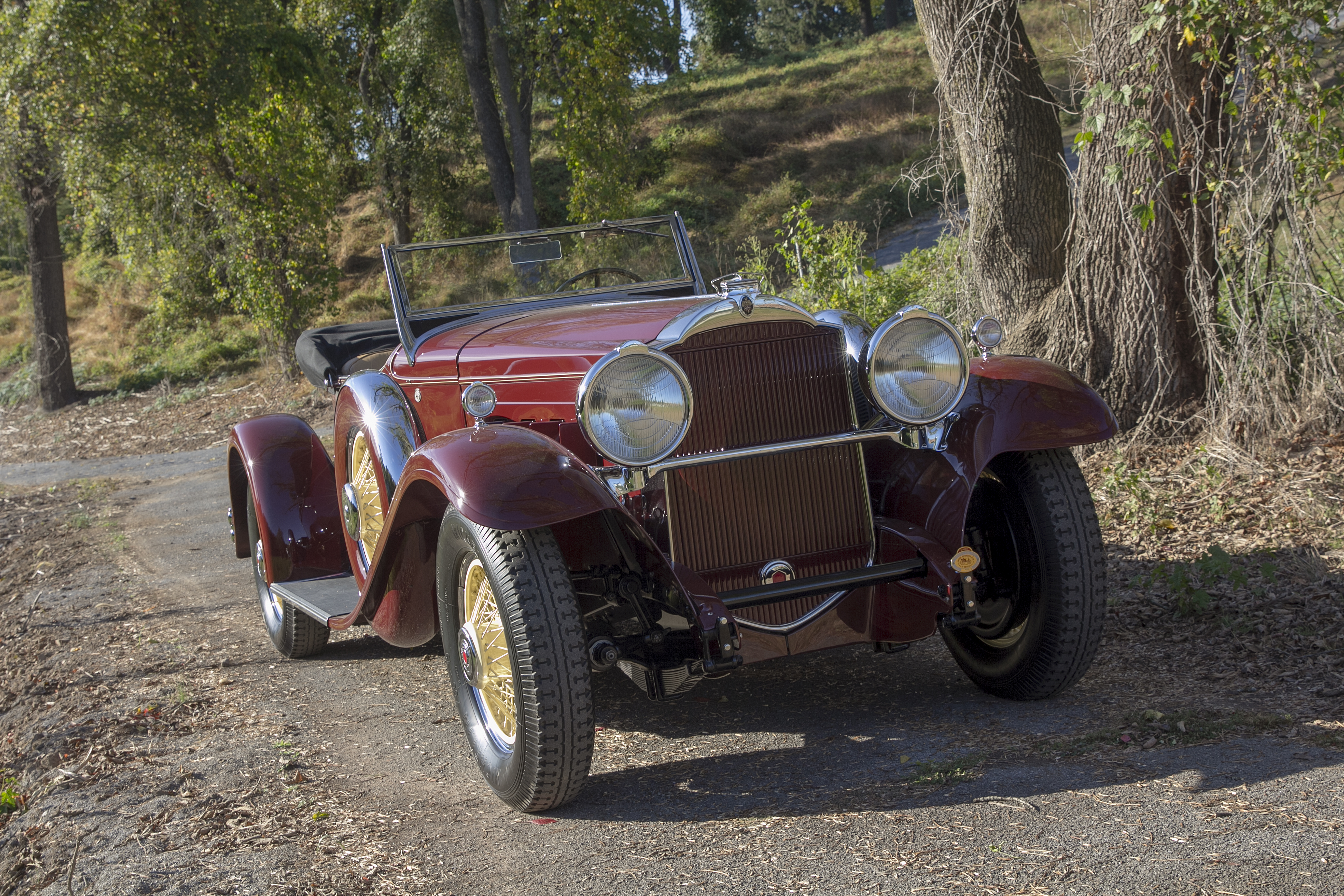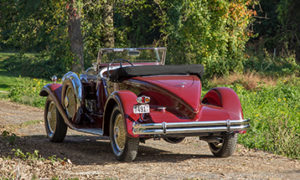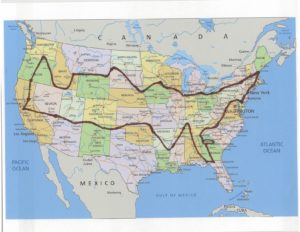
This article is one of the feature articles in the book produced by Grundy Insurance called, “The Allure of Rallies and Tours“. For more information on the book visit our website at www.Grundy.com.
By way of introduction, it is my honor to introduce you to one of the most active members of the Classic Car Club of America (CCCA), Don Peterson, a veteran of 77 CCCA CARavans. I came to know him in 1989 through my association with Car Collector magazine, of which he was the co-owner and editor. He will be the first to tell you that touring is all about the memories forged from both good and challenging experiences. I chose to feature the following narrative because Peterson captured and logged his touring experiences participating on a coast-to-coast CCCA CARavan while achieving his personal goal of touring in all 48 contiguous states in a classic car. It gives great insight to anyone considering the idea of participating on a tour or rally, and also sets the tone for this publication. — Jeffrey Broadus
 One Lap of America
One Lap of America
48 States the Hard (Easy?) Way
by Don Peterson
The idea of driving a classic car through 48 states on one trip did not come all at once, but the seed may have been sown in November 1966 when I proposed that the CCCA do a coast-to-coast CARavan in 1972. It didn’t happen then, but a quarter-century later the club announced that they would be doing a coast-to-coast in June 1995. I, of course, signed up.
When picking a car for a monumental journey of this sort, the three most important factors are reliability, reliability, and reliability. Packard, of course, comes immediately to mind, and by sheer incidence I had two. There are several other considerations: speed, space, comfort, and je ne sais quoi. The One-Eighty limousine had the first three in spades, but the Speedster boattail runabout was even faster and it had elan. So the Speedster it was.
After thorough preparation (brakes, tune-up, re-packing the water pump, balancing wheels, etc.), we were ready for the first leg: Atlanta to the tour’s starting point in Newport, Rhode Island. I was accompanied by my oldest son, Wyatt, who is also no stranger to cross-country travel in a vintage automobile. The first day’s drive to Winchester, Virginia (633 miles) was a breeze, other than driving through the tail of Hurricane Allison for 500 miles with the lone windshield wiper on, then having the fog get so thick that we were forced to leave the Blue Ridge Parkway for regular roads down the Shenandoah Valley.
Trouble Strikes
The next day, after visiting Harpers Ferry and the Antietam battlefield, we noted an ominous rise in the water temperature gage. Topping the tank with water brought things back to normal, but just as we entered the Delaware toll road the gage again began to rise. By adding a couple of gallons of water every 80 miles or so, we limped into Westfield, N.J., the residence of my wife’s sister and husband. After discussing with my mechanic back in Atlanta, it was decided that a back-flush of the radiator was needed. The next morning, after finding an ad in the yellow pages for IC’s Radiator Repair (“vintage cars our specialty”), which featured a picture of a 1934 Packard coupe-roadster, we arrived at the Plainfield, N.J., shop just before opening time. Although he was very busy, the accommodating John Kavenaugh immediately set to work on the back-flushing operation. While he was doing that, Wyatt discovered that the right rear wheel had a seven-inch stress fracture in the rim and the tire was beginning to bulge out at that point. So, while the engine got its flush, we did a wheel change. After 90 minutes, the redoubtable Mr. Kavenaugh had completed three flushes and the car was ready to go again. (The water was remarkably clear, which worried me somewhat.)
Through the Lincoln Tunnel, past Times Square and Central Park, eastward we sped, arriving in Newport by midafternoon. Wyatt, now apprehensive about wheels, examines them again in Newport and found the spare we had installed the day before had thrown a two-by-five-inch chunk of tread somewhere, apparently in Connecticut. Our spare situation was now one good tire and one good wheel, but a mix-and-match would be required before either would do us any good.
By now, even though the sledding had not been 100% smooth, the idea of driving through all 48 contiguous states on one trip began to jell. I hadn’t mentioned it to anyone at this time, but had covered the bases by making sure we drove through West Virginia and Delaware on the way to the start, two states we surely would have missed had we gone a more direct route. Since the first leg of the official tour was heading west to Poughkeepsie, New York, via Connecticut, I needed an excuse to make a side trip to enter the three northern New England states. Telling Wyatt I wanted to see Lexington, Mass., and Concord, N.H., before I took the Big Dirt Sleep, we headed north to Boston. The car was running well, and after a visit to Lexington’s village green, we continued north to Portsmouth, N.H,. just across the river from Kittery, Maine (where we filled with gas, lest anyone dispute that we’d been there.) We then headed west to Concord, followed by Bennington Vermont, and to Cobleskill, New York, where we spent the night after roughly 375 miles. We rejoined the tour the next day in Olean, N.Y., after we had seen the Cornell campus in Ithaca, then Wakins Glen, followed by the new Glenn H. Curtiss Museum in Hammondsport, and in the process seeing three of New York’s beautiful Finger Lakes. (Along the way we chanced upon the Sixteenth Annual Algonquin Old Car Show in Bainbridge, NY., where we spent a couple of hours, got a nice dash plaque and met some great car enthusiasts. We were hoping to receive the longest distance travelled award, but neither did they have one, nor, for that matter, did we have room for it). At this point, although we had already passed through 15 states, I was still not yet ready to announce my intentions to drive through the entire lower 48.
Apart from a tree falling across the road in front of us and blocking the road on a detour in Pennsylvania, nothing unusual occurred by the time we reached our overnight stop in Hudson, Ohio. The next day we put the top down (it stayed down until Oregon) and made a stop at the ACD Museum in Auburn, Indiana, on the way to a two-day stop in Elkhart, Indiana, via a slight dip to the north through Sturgis, Michigan. Although the Speedster was still running very well, I’m sure it appreciated the day off when the group proceeded (by air-conditioned busses) to the CCCA Museum in Kalamazoo, Michigan. This facility is worth a stop for any vintage car enthusiast and mandatory for classic car aficionados.
By now, Wyatt’s vacation was at an end and I proceeded on to overnight stops in Rockford, Illinois, and Lacrosse, Wisconsin, alone. This ended one leg of the club’s three-week tour, and here I was joined by my wife, Edie, and youngest son, Ryan. The next two days were the longest and hottest of the CCCA tour: 810 miles to Rapid City, South Dakota, with an overnight stop in Yankton in between, and with the temperature in the 90s all the way.
An Awful Sound
As we neared the village of Colome, S.D. (pop. 309), a terrible rattling sound emanated from the engine compartment. After limping into town, my friend Bob Agnew from Albuquerque diagnosed the problem. The bushing in the water pump had failed, allowing the impeller to scrape the inside of the pump housing. The lady who owned the corner gas station allowed us to use her service bay, and off came the radiator, then the pump. It turned out that Colome had a first-class machine shop and the owner turned a new bushing for us in less than two hours, adapting parts he had on hand. Thanks to Bob’s efforts our total downtime from “awful sound” to “on the road again” was barley four hours. On, then, through Badlands to Rapid City.
The next day, as the CARavan visited Mt. Rushmore and other points in the Black Hills as part of another two-day stop (we had already done this drill in 1991 in our 1942 Packard on the way to Alberta), it was fish or cut bait time. We needed North Dakota and Montana if our epic journey was to be completed. Dare we leave Bob Agnew, the service truck that followed the tour (with mechanic), and the rest of the entourage and head north into the bleak and sparsely-inhabited area of western North Dakota and eastern Montana on our own? Why not! So we sped to Bowman N.D., then west to Miles City, Montana, for our overnight stop. The next day, after stops in Northern Cheyenne Craft Center in Lame Deer, Montana, and the Little Bighorn Battlefield (site of Custer’s last stand), we motored on south to Sheridan, Wyoming, and once again rejoined the CARavan.
Attacking the Bighorns
The following morning provided the first test of all the cars on the tour: a pair of 9,000-plus- foot passes between Dayton and Greybull.
When crossing a high pass in an old car you have four things working against you: 1) The boiling point of water drops one degree per thousand feet; 2) As the car climbs it works harder (often in a lower gear), thus creating more heat; 3) As the coolant heats, it expands out the overflow giving you less fluid remaining to cool the engine; and 4) As you go uphill, you lose speed and therefore the fan turns more slowly and the cool air through the radiator slows down. Modern cars, beginning around 1937, had pressurized cooling systems that solved most of these problems) especially if there is an expansion tank) and makes the mountain driving a breeze. Needless to say, by the time we reached the top of the pass we needed to add water to the radiator. But we hadmade it and proceeded with confidence toward the next (and final) big test; crossing the Grand Tetons four days later.
With the Bighorn behind us, we continued on to Cody, Wyoming, for our overnight stop, taking the opportunity to attend the local rodeo in the evening. The next day we entered Yellowstone, and then headed south to Jackson via the spectacular Grand Tetons. This ended the second week of the of the official three-week CCCA tour and we were joined here by quite a number of cars, most from California, which had signed up for the third week drive.
Week Three of the Official Tour
The 425-mile trek from Jackson Wyoming, to Nampa, Idaho, may have been the tour’s toughest day for many cars and drivers. It was opened by the steep climb through the 8,429-foot Teton Pass (looking back, you can see why they call Jackson “Jackson Hole”), then westward along the Oregon trail through the Idaho desert on another very warm day. Still, we hear few complaints and most of the cars did very well on this leg.
We now faced our biggest detour of the trip: going from Nampa to Bend Oregon, we somehow had to pass through the state of Washington. Once again, we threw caution to the wind and instead of heading straight west, we pointed the nose of the Packard northwest to Pendleton and Umatilla, where we crossed the Columbia River on top of the McNary Dam, then preceded down the Columbia for 75miles before heading straight south into Bend. For the first time, I was convinced we’d actually complete the goal of driving through the lower 48.
The 205-mile trip from Bend to Grants Pass included a stop at the fabled and unforgettable Crater Lake National Park, for me one of the trip’s major highlights. The powerboat cruise on the Rogue River the next day was also well worth the time.

California at Last!
U.S. 199 took us into California, where the official CCCA route used the coastal highways (first off U.S. 101, then California 1) most of the way to San Francisco. Down through the Redwood forest, including the Avenue of the Giants, with (of course) the obligatory photo of the car driving through the tree, we sailed, now confident that we would complete the official CCCA Coast-To-Coast tour.
Another photo opportunity (the car with the Golden Gate Bridge in the background) then through downtown S.F. to Treasure Island, the site of the 1939 San Francisco World’s Fair, then on to Danville where the final banquet was held at the spectacular Blackhawk Museum. Of the 45 CCCA Classics that signed up for the tour, 41 actually got the job done, an excellent showing for cars that averaged nearly 60 years old during this period.
Without A Net
At this point, Edie caught a plane back to Atlanta so she could return to work. (Someone’s got to pay all these bills!) Ryan (nine years old) and I were on our own. We still had 3,300 miles of desert, mountain and prairie to cover before our quest was complete … 3,300 miles with no trouble truck, no other classics, and nothing between us and disaster except for a Visa card. The first day out of the bay area, we headed south to Bakersfield, then on across the Mojave through Tehachapi, Barstow and Needles to our proposed overnight at Laughlin, Nevada … “Little Las Vegas,” I call it. Being the 2ndof July and the beginning of the 4thof July weekend, there wasn’t a room in town, nor across the river in Billhead City, Arizona. This precipitated our only night driving of the entire tour. It was very dark when we arrived in Kingsman, Arizona, where we got a motel room after a grueling 563-mile day. (Have you ever crossed the Mojave on a July afternoon in an open car?)
Ryan’s Agenda
Ryan was now, of course, the official navigator, so it was up to him to make sure we didn’t miss any of our remaining (after California) 16 states. This could be tricky as we needed to include all of the sunbelt states plus the peripheral “boarder states” of Kansas, Missouri and Kentucky. So from Kingsman, he routed us from the Four Corners area via the little known Wupatki and Sunset Crater Volcano National Monuments northeast of Flagstaff. (We had done the Grand Canyon a year earlier in the 1942 Packard.) We arrived at Four Corners 25 minutes after the gates closed, but the Native American in charge, bemused by our quest and astounded that we were not bent on photography allowed us to run through, make two loops around the marker and immediately exit. We now had Utah and Colorado covered, and headed for our overnight stop in Farmington, New Mexico. I think at this point, I saw a bit of light at the end of the tunnel, but Ryan said he thought it was an oncoming train. Time would tell.
Old Route 66
Heading east out of Albuquerque, we followed the path of old U.S. 66, which one could see from time to time and even with some bypasses available for travel here and there. With just a little difficulty, I remember using it on a trip to California in a 1938 Chevrolet right after WWII.
At the western city limits of Amarillo is the famous Cadillac Ranch, with its famous ten buried-to-the-windshield Cadillacs (1955 through 1961) angled into terra firma walking distance from Interstate 40. Ryan was more impressed with the prodigious amount of graffiti on the cars than the symbolism of a man who ran Cadillacs into the ground years before Roger Smith.
The next day, July 5thwe entered Oklahoma City just past noon with a water pump badly in need of replacing. We made a brief stop at the hole in the ground that was once the federal building, observed a moment of silence, then drove into European Motors, a repair shop that specializes in foreign cars. My reasoning was that, during the years so many foreign cars in distress had pulled into shops that serviced American cars that it was time for payback. The shop was only about six blocks from the bombing, close enough that the windows on the south wall (and door) had been blown out by the explosion. Fortunately, no one had been hurt. Mike Colliver, the technician, was intrigued by the car, and he set immediately to work repacking the water pump (which took nearly an hour), then refused to accept payment for his work! We thanked him profusely, then continued on to Tulsa and the overnight stop in Joplin, Missouri, cutting off the extreme southeast corner of Kansas as we entered Joplin. Forty-one down and seven to go!
Disaster Strikes
The next day we headed east across Missouri, entering Kentucky just across the Ohio River bridge from Cairo, Illinois, then proceeded to Memphis, where we spent the night. In the morning, as we made a sudden half-right turn into Clarkston, Mississippi, disaster. The left rear tire made contact with the fender, blistering the paint and bringing the car to a screeching halt. The left rear axle had broken just 2½ inches from the end. We were towed a couple of miles into Little Willie’s Wrecker Service in Clarksdale, where the axle was removed and final diagnosis made. While I made a half-dozen frantic phone calls to Packard people to see if I could locate a replacement (we still had Arkansas, Louisiana, Alabama, and Florida left to go!). Willie Singletary took another track: locating someone who could weld the axle. Willie won that race, finding a welder who normally works on farm machinery in a shop 10 miles east of town. We delivered the axle to him, and early the next morning it was ready to re-install. It worked perfectly and the final 978 miles through Arkansas, Louisiana, Alabama, and Florida went without incident, the route taking us through Mobile, Ala., and the corner of Escambia County in Florida (our 32ndday of the trip. The next day we were home at noon … 9,638 miles and 33.3 days of travel.
Would I do it again! You bet! What’s Next? Paris to Peking?
A Baker’s Dozen of the Questions Most Frequently Asked
When you’re on a cross-country trip in a vintage car, people at gas stations, restaurants and traffic lights always seem to have questions. Those most frequently asked:
1) What kind of car is it?
Since it had been nearly 60 years since the last real Packard was built, and since the only place on the car that says “Packard” is 3/8th-inch letters on the hubcaps, many onlookers are puzzled about the marque even after examining the vehicle.
2) What kind of gas mileage do you get?
This, of course, depends upon the terrain and how fast one is driving. We can get as high as 15mpg if we drive conservatively.
3) What would you do if the car broke down?
Fix it! The only other choices are to abandon it or have it towed 2,000 or miles home.
4) What tools are you carrying?
I haven’t found anything yet that a jack, tire wrench, water pump pliers, screw driver and a Visa card won’t fix.
5) Where do you carry your luggage?
That little triangular-shaped trunk in the boattail necessitates packing light.
6) Why is the passenger set back eight inches further back than the driver’s seat?
This reflects the sporting nature of the car, dating back to the days of the riding mechanics/navigators in race cars who always sat further aft. There are rumors that the car was developed to run at Le Mans, but that never happened, nor has it been confirmed.
7) What is the significance of the license number 8?
Only that it’s an eight-cylinder car.
8) How fast will it go?
Track tests done at the time the car was new show that it was tested at just over 100mph, but I have never personally exceeded 80mph. We usually drive about 60.
9) How long have you owned the car?
I purchased the car in 1973 and have driven the car more than 60,000 miles.
10) Where do you get tires for it?
When I joined the CCCA 64 years ago, tires were perhaps the number one problem for drivers of Classic cars. Today, however, there are a number of manufactures and sources if I need a new tire.
11) What kind of gas does it use?
Usually the lowest octane available is fine. When the car was new, Phillips 77 was about the best gas you could get. Today, even in the mountains west, we seldom see lower than 85 octane at stations. We don’t add lead additives because we don’t consider it necessary on this relatively low-compression engine (6 to 1). We also avoid ethanol additives.
12) Don’t you ever wash the car?
I purposely did not wash the car as I didn’t want onlookers to think that this Georgia car just arrived in California on a trailer.
13) Is that a straight-twelve engine like my Uncle Harry’s LaSalle?
Exactly!
Just The Facts Ma’am
1930 Packard Model 734 Speedster-Runabout
Original Price: $5,210
Engine: 385cdi/145hp flathead straight-eight
Transmission: four-speed plus reverse
Rear ratio: 3.31 to 1
Number of states visited: 48
Time of trip: 33 days and seven hours
Mileage: 9,638 Miles
Average daily mileage: 290 miles (highest 633)
Amount of gas used: 764.2 gallons
Fuel economy: 12.6mpg
Cost at time of trip in 1995
Cost of gasoline: $917.71 (avg. $1.20 per gallon)
Gas cost per mile: $ .095
Most expensive gas: $01.79 (California Highway 1)
Cheapest Gas: $ 01.019 (Georgia Highway I-85)
Number of gas stops: 54
12 National Parks and Monuments visited
Total mileage on the car: circa 300,000







